Automotive HUD research: AR HUD is being largely mounted on vehicles, and local suppliers lead the way.
1. AR HUD is being used widely, with 35,000 vehicles equipped in the first half of 2022.
Since 2021, AR HUD has been installed in multiple new vehicle models, including Mercedes-Benz S-Class, Hongqi E-HS9, Great Wall Mocha, Geely Xingyue L, Volkswagen ID Series, GAC Trumpchi GS8, BAIC Mofang and Rising R7.
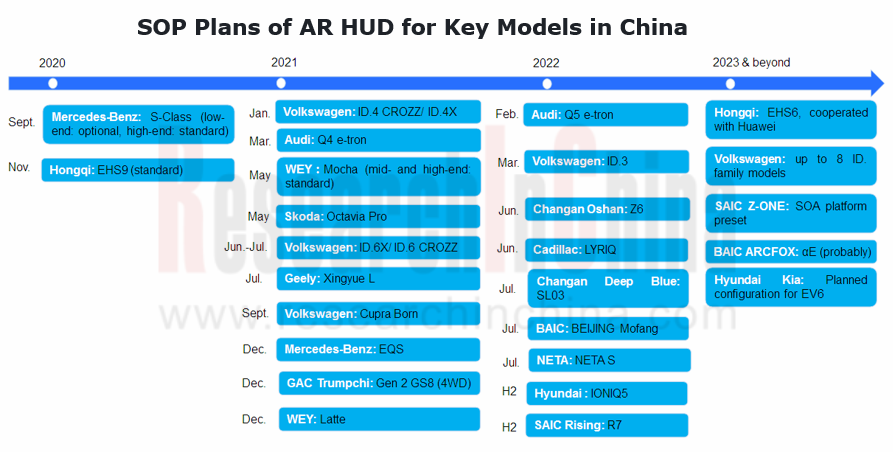
According to ResearchInChina, in the first half of 2021, 603,000 new passenger cars in China were equipped with HUD (C/W/AR), a like-on-like upsurge of 36.2%, of which 35,000 units packed AR-HUD, sharing 5.8% of the total, up 5.0 percentage points from the prior-year period.
From the monthly trend, it can be seen that the installations of AR HUD have been rising since mass production in early 2021, and began to surge in April 2022 after first outnumbering C-HUD in August 2021.
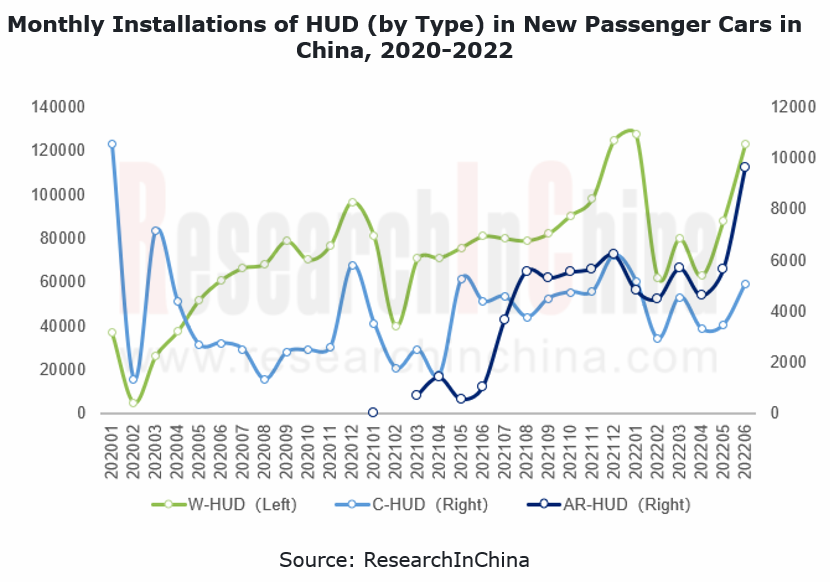
2. PGU becomes the key technology for realizing mass production of AR HUD.
At present, although many an OEM has launched AR HUD-enabled models, almost all of them are testing water on small scale. As for wide adoption, such problems as image distortion, sunlight inversion, high cost, and large size have yet to be solved. As a core component of AR HUD, PGU has become the key solution to the above problems.
There are four PGU technologies: TFT-LCD, DLP, LCOS, and laser scanning projection (LSP). Wherein, TFT-LCD and DLP are the mainstream solutions used in the current AR HUD-enabled production vehicle models in China. Volkswagen ID Series, Hongqi E-HS9 and WEY Mocha among others all bear TFT-LCD solutions. The DLP technology monopolized by TI delivers good imaging effects but its cost is high. The applied models include Mercedes-Benz S-Class and the 2nd-generation GAC Trumpchi GS8.
LCOS offering high resolution has made its way into the market in recent years. Typical vendors include Envisics, Huawei, ASU Tech, and Hardstone. SAIC Rising R7 released in May 2022 carries the LCOS-based AR HUD created by Huawei. The HUD features field of view of 13°*5°, luminance of 12000nits, and resolution of up to 1920×730.
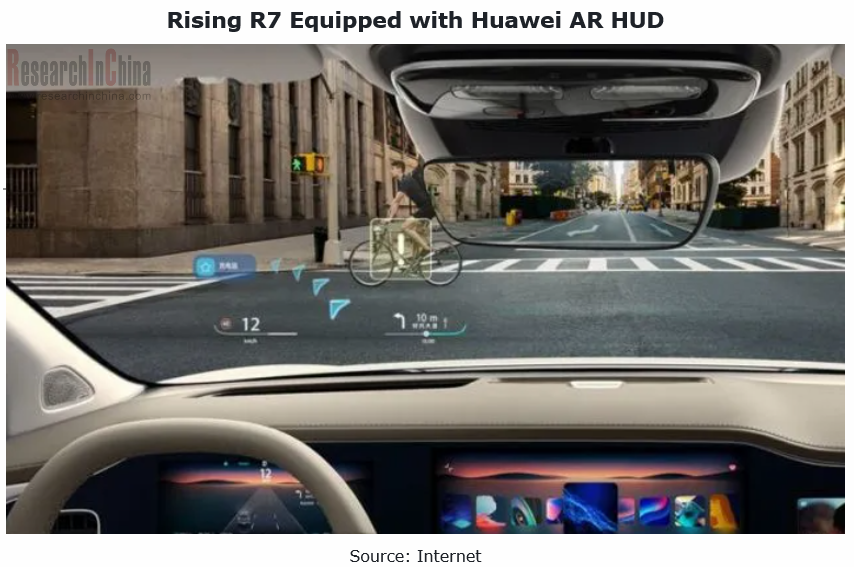
MEMS laser scanning projection (LSP) is also a R&D direction for some companies like Panasonic, Pioneer and Shenzhen Dianshi Innovation Technology. In 2022, the dual-vision laser holographic AR HUD jointly developed by Panasonic and Envisics is to be first mounted on Cadillac LYRIQ. With two projection display areas, far and near, the system can display real-scene markers at the destination, real-scene navigation, forward collision warning, and lane change command.
3. Local suppliers like Foryou lead in mass production of AR HUD.
OEMs’ increasing demand for AR HUD expedites technology iteration and product commercialization by suppliers. Thereof, China’s local suppliers like Foryou Multimedia have secured multiple mass production orders.
Foryou Multimedia is a HUD leader in China. As of June 2022, the company has shipped a total of more than 560,000 units, with customers including Great Wall Motor, Changan Automobile, GAC, BAIC, Chery and Vietnam’s VINFAST. In late June 2022, it signed a letter of intent with Huawei on in-depth strategic cooperation on intelligent vehicle accessories, especially AR HUD.
Foryou Multimedia also steps up its pace of new product iteration, having launched bifocal plane AR HUD and oblique projection AR HUD. Currently the bifocal plane AR HUD has been designated by Great Wall Motor, and the oblique projection AR HUD has been a substantive cooperative project of many automakers.
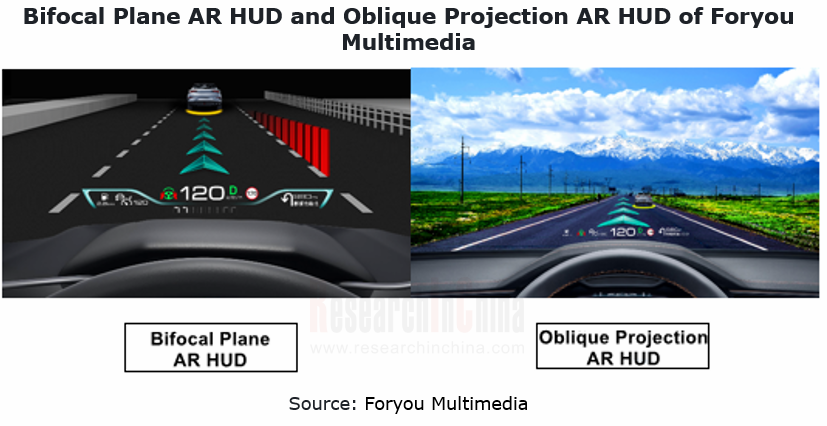
Zhejiang Crystal-Optech has partnered with quite a few OEMs to develop HUDs, and tries hard to mass-produce and market these products. Its AR HUD was produced in tiny quantities for Hongqi E-HS9 in March 2021, and was applied to Changan Deep Blue SL03 in July 2022. In the second half of 2022, Crystal-Optech is to provide HUDs including WHUD and AR HUD, for some models of Hongqi, Changan Automobile, BYD and Great Wall Motor.
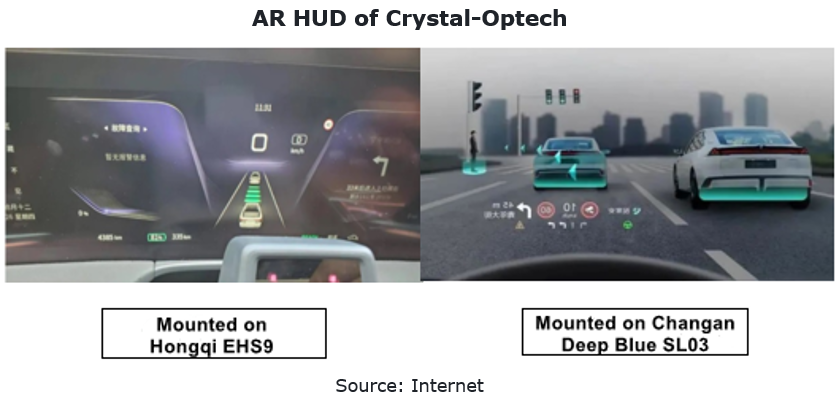
4. AR HUD will be integrated with multiple vehicle systems.
AR HUD has become a new window for human-vehicle interaction, which is accompanied by the evolution of intelligent driving to L2+. It will be integrated with multiple systems from dashboard, navigation and ADAS to DMS, infotainment and V2X.
In January 2021, Qualcomm announced its 4th-generation Snapdragon Automotive Cockpit Platform, a digital cockpit solution that supports multi-ECU and multi-domain fusion, covering dashboard and cockpit, AR-HUD, infotainment, rear seat display, electronic rearview mirror and in-vehicle monitoring. The system will be first available to cars of JIDU Auto and is projected to be mass-produced and delivered in 2023.
At the CES 2022, Harman demonstrated its AR HUD technology, which combines AR vision with the voice assistant that helps to recommend nearby points of interest. This technology can intelligently activate the autonomous driving mode, or allow the driver as an AR avatar to have a meeting with colleagues. In February 2022, HARMAN acquired Apostera, aiming to use Apostera’s augmented reality (AR) and mixed reality (MR) software solutions to cement its position as a leader in the automotive AR/MR field. Before that, Apostera had provided technical support of AR HUD for Audi Q4 e-tron.
At the CES 2022, Panasonic unveiled its AR HUD 2.0 system. Powered by Panasonic’s SkipGen2, its eCockpit infotainment controller, AR HUD 2.0 adds the eye tracking system (ETS), a patented technology that enables automatic driver height adjustment, dynamic parallax compensation, dynamic auto focus and driver monitoring capability. “The Panasonic AR HUD 2.0 continues the trend of up-integration of display domains, such as Cluster and HUD, into the central infotainment compute module,” said Andrew Poliak, CTO, Panasonic Automotive Systems Company of America.
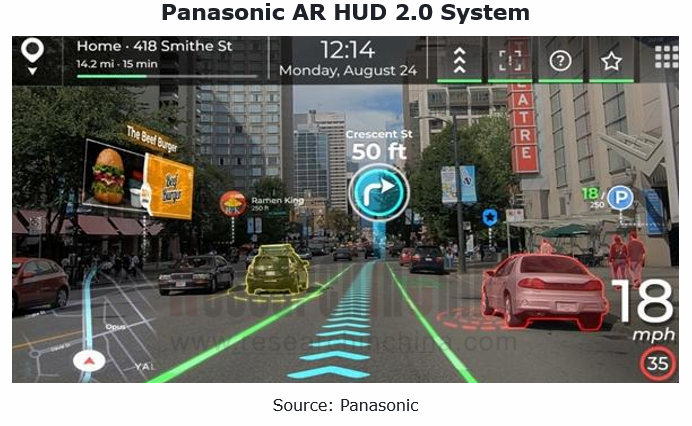
OEMs and Tier 1 Suppliers' Cost Reduction and Efficiency Enhancement Strategy Analysis Report, 2025
ResearchInChina released the "OEMs and Tier 1 Suppliers' Cost Reduction and Efficiency Enhancement Strategy Analysis Report, 2025", summarizing hundreds of cost reduction strategies to provide referen...
Automotive Fixed Panoramic Sunroof and Smart Roof Research Report, 2025
With the intelligent application of car roofs as the core, this report systematically sorts out a series of new products such as fixed panoramic sunroof/openable sunroof, ceiling screen, roof ambient ...
Automotive-Grade Power Semiconductor and Module (SiC, GaN) Industry Research Report, 2025
SiC/GaN Research: Sales volume of 800V+ architecture-based vehicles will increase more than 10 times, and hybrid carbon (SiC+IGBT) power modules are rapidly being deployed in vehicles.
Sales volume o...
Cockpit Agent Engineering Research Report, 2025
Cockpit Agent Engineering Research: Breakthrough from Digital AI to Physical AI
Cockpit Agent Engineering Research Report, 2025 starts with the status quo of cockpit agents, summarizes the technical ...
Prospective Study on L3 Intelligent Driving Technology of OEMs and Tier 1 Suppliers, 2025
L3 Research: The Window of Opportunity Has Arrived - Eight Trends in L3 Layout of OEMs and Tier 1 Suppliers
Through in-depth research on 15 OEMs (including 8 Chinese and 7 foreign OEMs) and 9 Tier 1 ...
China Commercial Vehicle IoV and Intelligent Cockpit Industry Research Report 2025
Commercial Vehicle IoV and Cockpit Research: The Third Wave of Passenger Car/Commercial Vehicle Technology Integration Arrives, and T-Box Integrates e-Call and 15.6-inch for Vehicles
I. The third wav...
Intelligent Vehicle Electronic and Electrical Architecture (EEA) and Technology Supply Chain Construction Strategy Research Report, 2025
E/E Architecture Research: 24 OEMs Deploy Innovative Products from Platform Architectures to Technical Selling Points
According to statistics from ResearchInChina, 802,000 passenger cars with domain...
Research Report on Intelligent Vehicle Cross-Domain Integration Strategies and Innovative Function Scenarios, 2025
Cross-Domain Integration Strategy Research: Automakers' Competition Extends to Cross-Domain Innovative Function Scenarios such as Cockpit-Driving, Powertrain, and Chassis
Cross-domain integration of ...
China Autonomous Driving Data Closed Loop Research Report, 2025
Data Closed-Loop Research: Synthetic Data Accounts for Over 50%, Full-process Automated Toolchain Gradually Implemented
Key Points:From 2023 to 2025, the proportion of synthetic data increased from 2...
Automotive Glass and Smart Glass Research Report, 2025
Automotive Glass Report: Dimmable Glass Offers Active Mode, Penetration Rate Expected to Reach 10% by 2030
ResearchInChina releases the Automotive Glass and Smart Glass Research Report, 2025. This r...
Passenger Car Brake-by-Wire (BBW) Research Report, 2025
Brake-by-Wire: EHB to Be Installed in 12 Million Vehicles in 2025
1. EHB Have Been Installed in over 10 Million Vehicles, A Figure to Hit 12 Million in 2025.
In 2024, the brake-by-wire, Electro-Hydr...
Autonomous Driving Domain Controller and Central Computing Unit (CCU) Industry Report, 2025
Research on Autonomous Driving Domain Controllers: Monthly Penetration Rate Exceeded 30% for the First Time, and 700T+ Ultrahigh-compute Domain Controller Products Are Rapidly Installed in Vehicles
L...
China Automotive Lighting and Ambient Lighting System Research Report, 2025
Automotive Lighting System Research: In 2025H1, Autonomous Driving System (ADS) Marker Lamps Saw an 11-Fold Year-on-Year Growth and the Installation Rate of Automotive LED Lighting Approached 90...
Ecological Domain and Automotive Hardware Expansion Research Report, 2025
ResearchInChina has released the Ecological Domain and Automotive Hardware Expansion Research Report, 2025, which delves into the application of various automotive extended hardware, supplier ecologic...
Automotive Seating Innovation Technology Trend Research Report, 2025
Automotive Seating Research: With Popularization of Comfort Functions, How to Properly "Stack Functions" for Seating?
This report studies the status quo of seating technologies and functions in aspe...
Research Report on Chinese Suppliers’ Overseas Layout of Intelligent Driving, 2025
Research on Overseas Layout of Intelligent Driving: There Are Multiple Challenges in Overseas Layout, and Light-Asset Cooperation with Foreign Suppliers Emerges as the Optimal Solution at Present
20...
High-Voltage Power Supply in New Energy Vehicle (BMS, BDU, Relay, Integrated Battery Box) Research Report, 2025
The high-voltage power supply system is a core component of new energy vehicles. The battery pack serves as the central energy source, with the capacity of power battery affecting the vehicle's range,...
Automotive Radio Frequency System-on-Chip (RF SoC) and Module Research Report, 2025
Automotive RF SoC Research: The Pace of Introducing "Nerve Endings" such as UWB, NTN Satellite Communication, NearLink, and WIFI into Intelligent Vehicles Quickens
RF SoC (Radio Frequency Syst...